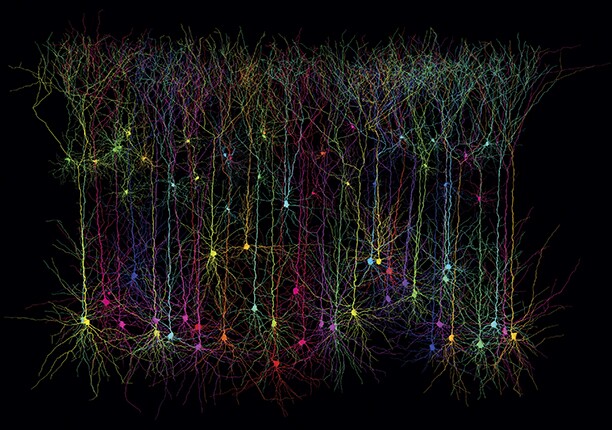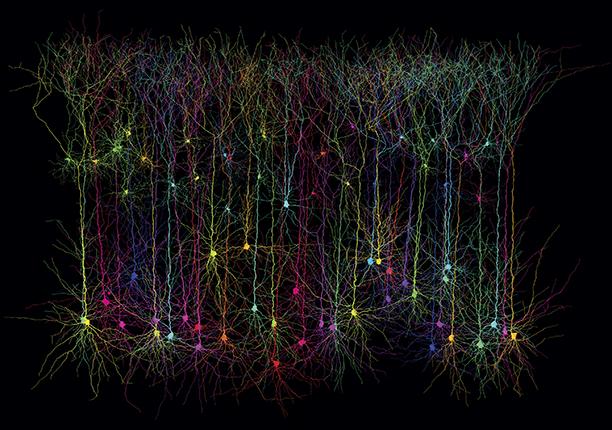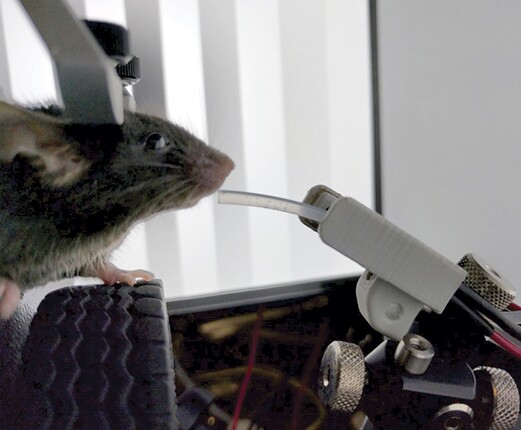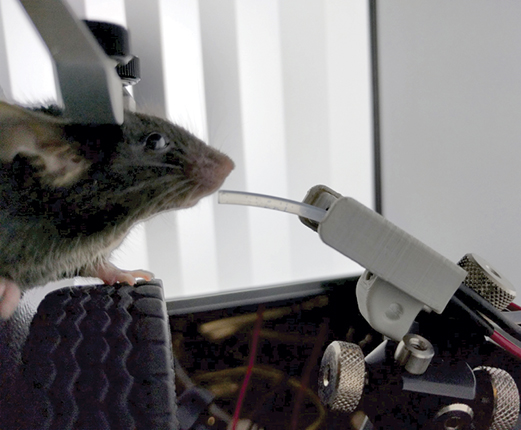Neuroscientists network to study the whole brain
DOI: 10.1063/PT.3.3918
Strides in understanding the brain have come from a medley of research efforts in recent years. But to a great extent, researchers in the field still work in an “artisanal, cottage-industry” way, says Michael Häusser of University College London. Variations in equipment and protocols complicate comparing and combining data to reach a holistic understanding of the brain.
Eager to accelerate progress in their field, Häusser and colleagues formed a plan in the fall of 2016 for a new paradigm for neuroscience research: Many groups—starting with 20 in Europe and the US—would adopt coherent approaches to their shared goals. The experimentalist members of the collaboration would study different parts of the mouse brain using identical setups so that their data could be readily shared and interpreted by others. The theorists would not only analyze the data, fit mathematical models, and develop new models, but also help guide the experiments. Given the similarity of the neurocircuitry of mammalian brains, the research could shed light on the human brain, too. “Nobody can figure out on their own how billions of neurons work together to generate behavior, so we know it’s a team effort,” says Alexandre Pouget, a theoretical neuroscientist at the University of Geneva.
Within a year, the team had secured awards totaling about $14 million from the UK’s Wellcome Trust and the US-based Simons Foundation to get started on achieving its vision, called the International Brain Laboratory (IBL).
The biggest challenges and the greatest potential for the IBL are both sociological, says Zachary Mainen, codirector of research at the Champalimaud Centre for the Unknown in Lisbon, Portugal. “We need to find ways to work together that are compatible with the incentive structure for individual investigators.” So the IBL researchers are looking to successful mammoth physics projects, such as CERN and LIGO (Laser Interferometer Gravitational-Wave Observatory), for inspiration and ideas on governance, data sharing, and more.
How are decisions made?
Taking a cue from the physics experiments, the IBL team set a clear goal that seemed realizable within 5–10 years: Map neuronal activity across the whole brain during a decision-making task.
A task involving perceptual decision making—receiving sensory input, making a judgment, and taking an action—summarizes much of what the brain does. “We do it all day long,” says Pouget. “And even if a task is simple, the entire brain is involved.” For the IBL’s first scientific goal, he says, “we have narrowed the stimulus and the task to bare bones.”
For the initial experiment, mice are trained to indicate whether an image on a screen is to the left or right of center. They are rewarded with a drink. The apparatus, which includes many 3D-printed parts and a Lego wheel, is intended to be identical across the labs, as are the training methods, rewards, and data collection and format.
“We all have the same hardware and the same software,” says Anne Churchland, whose group at Cold Spring Harbor Laboratory in New York is one of three to have set up the experiment so far. “We train the mice in the same way, present the same stimuli,” she says. “We operate as one large virtual lab.”
For different groups to construct identical experimental setups is tougher than it might sound. Using the same equipment, the same stimulus patterns, and the same reward schedule is easy. But many activities related to an experiment develop organically and may go unsaid. When and what are the mice fed? Are animals transferred from their home cage to the testing setup in the same way? How will researchers handle differences in the rates at which animals learn a task? Are the experiments carried out at a certain time each day? “Because we aim to combine data,” says Mainen, “we’d like to think it doesn’t matter whose lab the mouse came from and that a neuron from one mouse is the same as from another mouse. But there will be noise.”
The data will consist of electrical measurements from firing neurons. The firing involves a transient voltage fluctuation across the neuron membrane, and that signal, or action potential, is measured. The team also plans to use two-photon microscopy for high-resolution calcium imaging to determine the roles of different neuron types. In addition, video imaging will record pupil dilation, paw movement, and other behavioral data. “We are sure that the brain is not fully dedicated to the stimulus and one type of movement, so we need to take into account other variables,” explains Mainen. A data-gathering session typically lasts an hour, during which a mouse completes about 400 perceptual decision-making trials.

Computer simulations of neural networks are part of efforts by the International Brain Laboratory to understand how neurons work together to drive behavior. This image shows pyramidal cells in the rodent cerebral cortex.
HERMANN CUNTZ AND MICHAEL HÄUSSER, UNIVERSITY COLLEGE LONDON

A host of advances and new tools for remote communication and data handling make the IBL’s goals and its collaborative methods feasible. The most significant technical advance is a new probe called Neuropixels. The thinner-than-hair silicon wire, with 960 electrodes along its 10 mm length, is inserted into the brain to measure action potentials. “It can record many more neurons, from many layers, down to the subcortical structure,” says Churchland, and the signal-to-noise is better than with other electrodes. “It’s a game changer.” As a postdoc a decade ago, she recalls, she recorded from 75 neurons total over three years. “Now people get 600 a day!” Once all 10 experimental groups have started studying their chosen areas of the brain, the IBL will collect signals from thousands of neurons per day.
That trove of data will be the theorists’ sandbox. The analysis will involve a lot of machine learning. As the animals are trained, mathematical models will be fitted to their behavior to determine whether the mice use the same strategies to solve the task. “This is an essential piece of information since we want to integrate data across labs,” says Pouget. Another goal is to untangle spike-train recordings, which are typically from multiple neurons, to recover single-neuron responses. Those are all steps toward the overarching aim of developing a whole-brain theory that explains how “millions of neurons compute, communicate, and orchestrate their activities to produce decisions that can maximize their reward,” he says.
For experimentalists and theorists in neuroscience to work hand in hand has been “rare and haphazard,” says Häusser. “We need to sit down together from the beginning. We want theorists to help drive the experiments.”
“A sociological Big Bang”
Christof Koch, president and chief scientific officer of the Allen Institute for Brain Science in Seattle, describes neuroscience as being in the midst of a “sociological Big Bang.” Worldwide, he says, roughly 10 000 individual labs are pursuing their own goals, using their own tools, and working with their own choice of animal—spiders, rats, monkeys, fish. The IBL is part of an ongoing phase change in the field, toward big science and big data, he says. (See also the interview with Koch at http://physicstoday.org/koch
The not-for-profit Allen Institute got started in 2003 and was followed some years later by the launch of large brain initiatives in Europe, the US, and elsewhere (see Physics Today, December 2013, page 20

A mouse turns the wheel to indicate whether a visual stimulus appears to its left or right and receives water from the spout for the correct answer. International Brain Laboratory scientists aim to map the neuronal responses during such decision making.
FANNY CAZETTES/CHAMPALIMAUD CENTRE FOR THE UNKNOWN

IBL members point to the Allen Institute as a model. But the institute’s 350 researchers are in one building, whereas the IBL investigators are dispersed among various academic institutions. Even under one roof and one management, getting people to align their research can be tricky, says Koch, who is on the IBL scientific advisory board.
When the Allen Institute was getting started, Koch visited the Large Hadron Collider and asked the leaders there about the secret of success. “They said, ‘Talk, talk, talk. Meetings, meetings, meetings.’ ”
One concern, says Häusser, is that making decisions jointly can be inefficient. The team is taking a consent—not a consensus—approach, he says. The approach involves making sure everyone understands a proposal and has opportunities to raise objections and suggest solutions. As the idea for the IBL took shape, Mainen was inspired by the nonhierarchical structure of the ATLAS collaboration, a CERN experiment with roughly 3000 participants. With around 40 members total, the IBL is much smaller, but the idea is to put governance structures in place now in preparation for it to grow, he says.
There is a large activation barrier to working as a huge group, says Princeton University’s Ilana Witten, who chairs the IBL working group on publications and postdocs. An individual can work faster alone, making independent decisions. “But if we can overcome the activation barrier, the promise of standardization is that science will move more quickly. It will lead to more results—and more reproducible results.”
Another barrier is that sharing data is not part of the neuroscience culture. “It’s been said neuroscientists would rather share their toothbrush than their data,” says Häusser. But the science questions are an incentive to develop a pipeline for putting the data together, and that will be a win, he says. The IBL data are freely available across the consortium. “I hope we will be able to get people in the field to be more open about sharing their data.”
Still, researchers are typically judged by their first-author publications, and standardizing experiments entails a tradeoff with individual creativity. Those are sociological challenges, says Mainen. “We need to show that people who work in the IBL will be well-recognized and land good jobs. A large-scale group effort need not diminish creativity.”
So far, the IBL represents perhaps 5–25% of the principal investigators’ funding. It’s the minimum to get started, says Mainen. The groups each have enough funding for one postdoc or graduate student. The grants also cover equipment and some travel.
Changing entrenched sociological behavior will be difficult, says Koch. “But teaming up is the way to go. It will happen. Neuroscience is no longer at the romantic phase of everyone chasing their favorite question. People want progress. People want therapy for Parkinson’s, for schizophrenia.”
More about the Authors
Toni Feder. tfeder@aip.org
